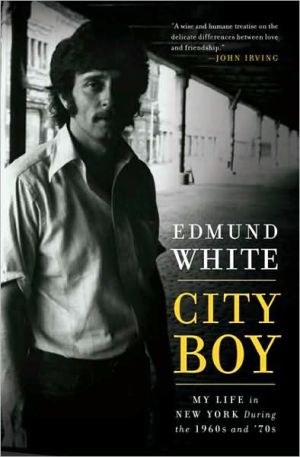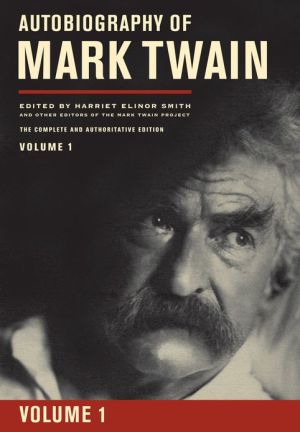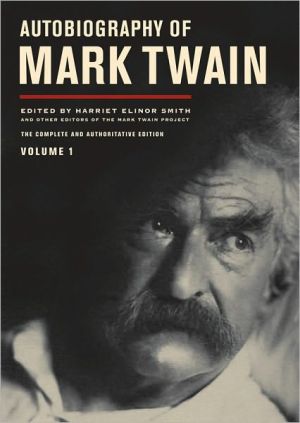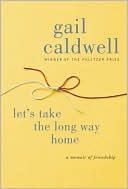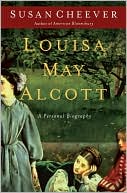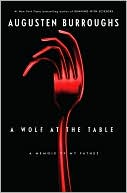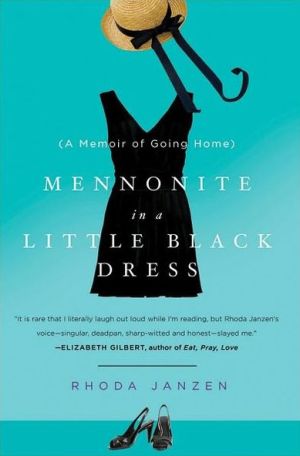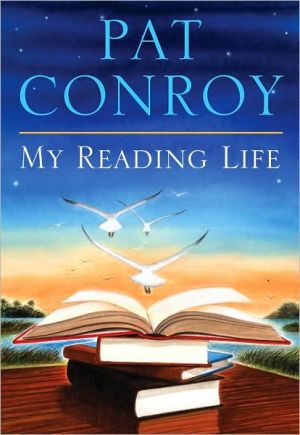City Boy: My Life in New York During the 1960s and '70s
An irresistible literary treat: a memoir of the social and sexual lives of New York City’s cultural and intellectual in-crowd in the tumultuous 1970s, from acclaimed author Edmund White.\ In the New Y ork of the 1970s, in the wake of Stonewall and in the midst of economic collapse, you might find the likes of Jasper Johns and William Burroughs at the next cocktail party, and you were as likely to be caught arguing Marx at the New York City Ballet as cruising for sex in the warehouses and...
Search in google:
Groundbreaking literary icon Edmund White reflects on his remarkable life in New York in an era when the city was economically devastated but incandescent with art and ideas. White struggles to gain literary recognition, witnesses the rise of the gay rights movement, and has memorable encounters with luminaries from Elizabeth Bishop to William Burroughs, Susan Sontag to Jasper Johns. Recording his ambitions and desires, recalling lovers and literary heroes, White displays the wit, candor, and generosity that have defined his unique voice over the decades. The New York Times - Dwight Garner …an open-throttled tour of New York City during the bad old days of the 1960s and early '70s: crime, graffiti, garbage in the streets, Steppenwolf and Foghat leaking out of car tape decks, gay men wearing whistles around their necks to summon help when ambushed by gangs. These bad old days morphed into a star-spangled gay coming of age in the decade after Stonewall…City Boy may lack some of the fineness and intensity of My Lives, which remains the essential Edmund White memoir, the one to read first. But this one is salty and buttery, for sure.
City Boy\ My Life in New York During the 1960s and '70s \ \ By Edmund White \ Bloomsbury\ Copyright © 2009 Edmund White\ All right reserved.\ ISBN: 978-1-59691-402-5 \ \ \ \ Chapter One\ In the 1970s in New York everyone slept till noon. \ It was a grungy, dangerous, bankrupt city without normal services most of the time. The garbage piled up and stank during long strikes of the sanitation workers. A major blackout led to days and days of looting. We gay guys wore whistles around our necks so we could summon help from other gay men when we were attacked on the streets by gangs living in the projects between Greenwich Village and the West Side leather bars.\ The upside was that the city was inexpensive, and Manhattan, especially the part of it below Fourteenth Street, was full of young actors-singers-dancers-waiters who made enough money working their restaurant shifts three nights a week to pay for their acting lessons and their cheap rents. Unlike our hometowns back in the Midwest, where the sidewalk was rolled up at six p.m., the delis and coffee shops were open all night and the bars till four in the morning. That whole army of actor-waiters saw their restaurant jobs as just another opportunity for "scene study" ("Who am I tonight? An Austrian aristocrat who's fallen on bad times? A runaway from an incestuous family in the Tennessee Hills? A Swedish gymnast?"). No matter how big their tips were, they managed todrink them away in a bar after the restaurants closed as they talked excitedly about their art and their loves. Everyone smoked all the time, and when you French-kissed someone, it was like rubbing one ashtray against another.\ New York seemed either frightening or risible to the rest of the nation. To us, however, it represented the only free port on the entire continent. Only in New York could we walk hand in hand with a member of the same sex. Only in New York could we ignore a rat galloping across our path and head out for a midnight play reading. Artists on the Lower East Side were recycling the most primitive and worthless materials-junk, really.\ But there was also a mandarin New York, a place where painters and choreographers and novelists and poets strove to produce serious art of the highest order. This was an elite group of people, scattered throughout the Village and the emerging neighborhood of Chelsea and the comfortable, kicked-out Upper West Side; in this mandarinate artists and intellectuals still felt connected to the supreme artists of the past, still thought that their work would be the latest installment in a quasi-divine legacy.\ I had constant daydreams of meeting Susan Sontag and Paul Goodman. I don't know why I focused on them-maybe because they were so often mentioned in the Village Voice and the Partisan Review but even by Time. He'd written Growing Up Absurd, the bible of the sixties, now largely forgotten (I never read it in any event). How could I have worshipped a man whose work I didn't know? I guess because I'd heard that he was bisexual, that he was a brilliant therapist, and that he was somehow for the young and the liberated. I read his astonishing journal, Five Years, published in 1966, a groundbreaking book in which he openly discussed paying men for sex and enjoying anonymous sex in the meatpacking district. Today that would seem unremarkable, perhaps, but for a husband and a father back then to be so confiding, so shameless, was unprecedented, especially since the sex passages were mixed in with remarks on culture and poetry and a hundred other subjects.\ Sontag was someone I read more faithfully, especially Against Interpretation and even individual essays as they were published.\ New York, in short, in the seventies was a junkyard with serious artistic aspirations. I remember that one of our friends, the poet Brad Gooch, wanted to introduce us to his lover, who'd become an up-and-coming Hollywood director, but Brad begged him not to tell us that he worked as a director since Hollywood had such low prestige among us. That sort of reticence would be unthinkable today in a New York that has become enslaved by wealth and glitz, but back then people still embraced Ezra Pound's motto, "Beauty is difficult."\ We kept asking in 1972 and 1973 when the seventies were going to begin ...\ Then again we had to admit the sixties hadn't really begun until the Beatles came over to the States in 1964, but after that the decade took on a real, definite personality-protest movements, long hair, love, drugs, a euphoria that turned sour only toward the end of 1969. Of course for Leftists the decade began with the Brown v. Board of Education decision and ended with Nixon's resignation in 1974.\ I suppose people hadn't really thought each decade should have its own character and be different from the others till the 1920s, although I remember in a nineteenth-century Russian novel someone remarked that a character was a typical man of the 1830s-progressive and an atheist. But at that time it seemed more a question of generations-one belonged to the generation of "superfluous men," for instance, or one was a frivolous, self-indulgent product of the Belle Époque. But certainly in the 1920s, as the idea of the modern became current, every amateur sociologist began to seek out the personality of the dawning decade.\ In retrospect we could see that the 1950s had been a reactionary period in America of Eisenhower blandness, of virulent anticommunism, of the Feminine Mystique. I lived through the fifties in the Midwest when everything that was happening-the repression of homosexuality, for instance, the demonization of the Left, the giggly, soporific ordinariness of adolescence, the stone deafness to the social injustice all around us-seemed not only unobjectionable but also nonexistent. Somehow we'd all been led to think that the order of things in the fifties was "natural," eternal and unchanging. The cult books of that epoch were The Lonely Crowd and The Man in the Gray Flannel Suit.\ The great triumph of the sixties was to dramatize just how arbitrary and constructed the seeming normality of the fifties had been. We rose up from our maple-wood twin beds and fell onto the great squishy, heated water bed of the sixties.\ At the end of the 1970s I wrote, "There was no style for the decade, no flair, no slogans. The mistake we made was that we were all looking for something as startling as the Beatles, acid, Pop Art, hippies and radical politics. What actually set in was a painful and unexpected working out of the terms the Sixties had so blithely tossed off."\ (Continues...)\ \ \ \ \ Excerpted from City Boy by Edmund White Copyright © 2009 by Edmund White. Excerpted by permission.\ All rights reserved. No part of this excerpt may be reproduced or reprinted without permission in writing from the publisher.\ Excerpts are provided by Dial-A-Book Inc. solely for the personal use of visitors to this web site. \ \
\ From the Publisher“[A] moving chronicle…that peacock’s tail, those stag’s antlers—they’re here, to be sure, but so are vulnerability, doubt, failure and long years toiling at the sort of cruddy day jobs that most literary writers know all too well…In City Boy, White is amusing and raucous as ever but he also lets the mask slip…his losses and struggles, as consequence, seems less sculpted, but more real….Some stories don’t need to be embellished to glow.” - New York Times Book Review "An open-throttled tour of New York City during the bad old days of the 1960s and early '70s… it's all here in exacting and eye-popping detail… There is a great deal of sex and gossip in City Boy, but it is also a minor-key account of Mr. White's coming of age as a writer… City Boy is Mr. White's second memoir in three years, and a great deal of his fiction has been autobiographical. You get the sense of a writer slowly peeling his life like an artichoke, letting only a few stray leaves go at a time… This one is salty and buttery, for sure. Mr. White's ''Oh, come on, guys'' meekness has vanished into thin air." - New York Times "City Boy is an amazing memoir of White’s hunger for literary fame — for publication even — and intellectual esteem in the superheated creative world of ’60s and ’70s New York. His sketches of writers and artists, including everyone from poets James Merrill and John Ashbery to artist Robert Wilson and editor Robert Gottlieb, are full of bon mots, sharply observed details, and great honesty about his own desires for love and esteem. City Boy vividly brings to life the sheer squalor of life in 1970s New York… A wonderful raconteur with a well-stocked fund of anecdotes and observations, White’s writings reveal much about alliances, alignments, and personalities from a vanished world that still echo strongly in our own." - This Week in New York\ “Edmund White is no one-trick pony. The prolific novelist, critic, memoirist, gay activist, professor and social aspirant has waded into countless literary and intellectual pools and sent visible ripples through each. White's latest book, a ruminative and rambling memoir of his time in New York City in the 1970s, takes readers on a dime tour through the writer's initiation into circles that spun with such blinding talents as Susan Sontag, Richard Howard, John Ashbery, Michel Foucault, even Vladimir Nabokov and Anthony Burgess… City Boy presents an exhilarating sketch of the grizzled, untamed and dangerous way of life that was New York in the 1960s and '70s… His New York was …a place where high and low collided in an irreproducible frisson of ecstatic creativity… White's reflections on what it meant to be an out ‘gay’ writer at a time when there was no such thing are valuable and illuminating… We're lucky for [his] pioneering work… White's latest reflection offers a valuable glimpse into the mind of an indispensable writer and critic.” —Buffalo News\ "The 1960s and 70s were a pivotal time for gay men, a time when homosexuals made history by redefining their role in society at large by standing up for the basic human rights we enjoy today – and then there's all that rampant, unbridled sex on the Chelsea piers. Popular gay historian, novelist, memoirist and survivor Edmund White takes us there in style in City Boy…. In his own classy, restrained, inimitable style, Edmund White presents graceful ruminations on an ungraceful time as one forgotten decade casts a long shadow on the one that followed. Simply put, this book is a gem, and if time travel were indeed a possibility, White would make the ultimate tour guide." —Bay Area Reporter "Chronicl[es] Gotham’s cultural highs and lows during those two heady and iconic decades... fleshing out our notion of how vital a period the ’60s and ’70s were... Since White is a born raconteur, his gimlet-eyed anecdotes about celebrities of the era are as tangy as blood orange sorbet served after lobster Thermidor... [he] matches his talent for journalism with brilliant imagistic prose." —Gay City News\ “A colorfully detailed remembrance…with his novelist’s brilliance in turns of phrase in evoking these places, [White] also recalls the many celebrated writers he encountered over the years in his slow climb to writerly success. A special invitation to a world gone by.” —Booklist\ “Novelist and critic White weaves erotic encounters and long-ago literati into a vast tapestry of Manhattan memories… How he overcame setbacks and confronted his insecurities to eventually write 23 books makes for fascinating reading…White writes with a simple, fluid style, and beneath his patina of pain, a refreshing honesty emerges. This is a brilliant recreation of an era, rich in revels, revolutions and ‘leather boys leading the human tidal wave.’” —Publishers Weekly\ "A graceful memoir of a decidedly ungraceful time in the life of New York City... A welcome portrait of a time and place long past, and much yearned for." —Kirkus Reviews "[An] exuberant, thoughtful memoir. ...Ambition, amphetamines, neurosis and an era when New York vibrated with desire combined for heady times in his young life... Sparkling cameo appearances by the likes of Truman Capote, Robert Mapplethorpe and Fran Lebowitz expand the feeling that artistic Manhattan then was a very different place than it is today... White's vivid analysis of his artistic struggles and literary progress during these years is like a master class for other writers... [His] memoir ... has charm to burn." —Shelf Awareness\ \ \ \ \ \ Dwight Garner…an open-throttled tour of New York City during the bad old days of the 1960s and early '70s: crime, graffiti, garbage in the streets, Steppenwolf and Foghat leaking out of car tape decks, gay men wearing whistles around their necks to summon help when ambushed by gangs. These bad old days morphed into a star-spangled gay coming of age in the decade after Stonewall…City Boy may lack some of the fineness and intensity of My Lives, which remains the essential Edmund White memoir, the one to read first. But this one is salty and buttery, for sure.\ —The New York Times\ \ \ Stacey D'ErasmoWhite is as amusing and raucous as ever, but he also lets the mask slip. The prose tends toward the straightforward; sex is mentioned but rarely described in detail; and if White is sometimes slightly cranky about, say, the state of literature today or certain eminent artistic closet cases…he is also more openly tender and affectionate. His losses and struggles, as a consequence, seem less sculpted, but more real…City Boy, plain-spoken and knowing, is a survivor's tale, a missive…this is who we were, this is how it was, this was our city. Some stories don't need to be embellished to glow.\ —The New York Times Book Review\ \ \ \ \ Publishers WeeklyNovelist and critic White (A Boy's Own Story; The Joy of Gay Sex) weaves erotic encounters and long-ago literati into a vast tapestry of Manhattan memories. He arrived from the Midwest in 1962, worked at Time-Life Books, haunted the Gotham Book Mart and went street cruising: “We had to seek out most of our men on the hoof.” In 1970, he quit his job to live in Rome, returning to find “sexual abundance” in New York. An editor with Saturday Review and Horizon, White knew artists, writers and poets, yet his own writing remained at the starting gate. He fictionalized Fire Island rituals for his first novel, Forgetting Elena (1971), which took years to find a publisher and then sold only 600 copies. Nabokov later labeled it “a marvelous book,” ranking White along with Updike and Robbe-Grillet. His second novel, about hetero/homosexual friendships, was never published, yet he “longed for literary celebrity.” How he overcame setbacks and confronted his insecurities to eventually write 23 books makes for fascinating reading. Along the way, he notes how Fun City became Fear City with the AIDS crisis, and he recalls meeting everyone from Borges, Burroughs and Capote to Peggy Guggenheim, John Ashbery, Susan Sontag, Robert Mapplethorpe and Jasper Johns. White writes with a simple, fluid style, and beneath his patina of pain, a refreshing honesty emerges. This is a brilliant recreation of an era, rich in revels, revolutions and “leather boys leading the human tidal wave.” (Oct.)\ \ \ \ \ Kirkus ReviewsFrom renowned novelist and essayist White (Rimbaud: The Double Life of a Rebel, 2008, etc.), a graceful memoir of a decidedly ungraceful time in the life of New York City. "In the 1970s in New York," writes the author, "everyone slept till noon." Also, "everyone smoked all the time, and when you French-kissed someone, it was like rubbing one ashtray against another." The era was one of aspiration and poverty, of a time before New York had "become enslaved by wealth and glitz," when "people still embraced Ezra Pound's motto ‘Beauty is difficult.' " There is much difficult beauty-and much French kissing-in these pages, which recount White's arrival to the city in 1962 as a transplanted Texan by way of Ann Arbor and his eventual assimilation. His arrival coincided with a slight but noticeable uptick in the general awareness that there were such a thing as gay people. White lived openly with a young man, but he still knotted his narrow tie carefully and went to work as one of the great silent majority. A "living contradiction," he reveled in gay weekends while roiling in self-hatred and seeing a psychotherapist in the hope of turning straight and getting married. The cure didn't take, and White's self-awareness grew with times that included the rise of the so-called Pink Panthers and the Stonewall Riots. Those were times of danger. As White recounts, wary Manhattanites negotiated the city block by block, shunning, say, 85th Street in favor of one on either side of it and generally keeping doors bolted and windows gated. But they were also times of liberating art, with White enjoying the company of intellectuals and writers-including Richard Howard ("Every moment with him had a sense ofoccasion"), Richard Sennett ("an odd combination of schoolboy nerd, flamboyant queen, and Mrs. Astor") and Simon Karlinsky-while publishing his first books and gaining recognition in the literary world. Full of small provocations-among them, "I sometimes regret the invention of the category ‘gay' "-this is a welcome portrait of a time and place long past, and much yearned for. New York City appearances. Agent: Amanda Urban/ICM\ \
